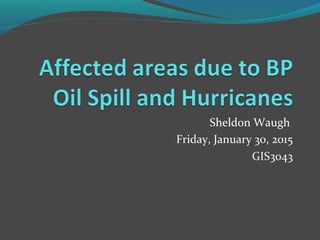
Final Project
- 1. Sheldon Waugh Friday, January 30, 2015 GIS3043
- 2. Introduction/Motivation The BP Oil Spill has been a forefront topic for the Gulf Coast States and the U.S for more than a month and a half. With the 2010 Atlantic Hurricane season upon us, many experts have explained that the oil on the ocean surface plus a U.S land falling hurricane will wreak havoc on the coastal environments and wildlife of the Gulf Coast. The goal here is to find the areas in the Gulf Coast most likely to be hit by a hurricane, and affected by the resulting oil pollution. A analysis like this would be beneficial to Gulf Coast States regional planning committees, for pinpointing a more concentrated area to divert their oil pollution prevention techniques.
- 3. Background The Deepwater Horizon (BP) Oil Spill is currently the largest offshore oil spill in United States history, surpassing the Exxon Valdez. The spill was initially created by the oil rig explosion of the Deepwater Horizon, killing 11 workers. Currently the spill has been recorded as 90.1 million barrels spilled with a spill rate of 40,000 barrels a day (1 Barrel = 60 Gallons). A stop to the flow of oil from the well has been predicted in some time in August. Covers roughly 2,500 Square Miles. The 2010 Atlantic Hurricane season started June 1st , 2010 (8-14 Hurricanes predicted, 3-7 Major Hurricanes)
- 4. Data Used/Sources Hurricane tracks obtained from NOAA(National Oceanic and Atmospheric Administration), (June-August Hurricanes over the last 140 years) U.S, Canada, Mexico and Cuba shapefiles obtained from the CDC (Center for Disease Control) Gulf Coastal Counties shapefiles obtained from the United States Census Bureau The Gulf Coast Sea level and CVI (Coastal Vulnerability Index) shapefiles were obtained from the USGS (United States Geological Survey). The following data was created by myself by goereferencing and digitizing jpeg images: Google Maps (.kml files) NOAA Oil spill location and 72 hour predictions as of 6/8/2010, the kml were then converted into jpeg images, georeferenced and digitized. The loop currents and gulf streams were obtained from the jpeg image that came from NASA’s MODIS satellite (5/18/2010)
- 5. Analysis 1. I georeferenced and digitized the jpegs for the oil spill (both the actual location, and the 72 hour locations) 2. I then georeferenced and digitized the jpegs for the loop current and the gulf stream ocean currents. 3. I then made a buffer from my 72 hour prediction polygon to make it my 2-month prediction polygon. 4. For the Hurricane data: I first selected out tracks that did not fall into my 3 month window (MONTH = June, July, August). I then selected out by location tracks that did not intersect with my 2 month oil spill prediction buffer. Finally I selected out the tracks that did not make landfall onto one of the four Gulf Coast States I paid attention to (Florida, Louisiana, Alabama, Mississippi) (selected by location hurricane tracks that intersected with the states layer). 1. I estimated storm surge in each area by combining sea level and CVI risk (Coastal Vulnerability Index- Index combines: Sea level Change, erosion wave size and frequency and posts it into a Low to very High index) 2. I then added the necessary regional boundaries
- 6. Analysis 7. After inputting my data, I created a fishnet grid that covered the Gulf Coast on my map. I made the scale to be 1 degree by 1 degree squares. 8. I then used the Feature to Polygon to convert the fishnet grid into a polygon grid. 9. After that, I executed a spatial join with the hurricane tracks to the polygon grid. 10. After the spatial join, I opened the attribute table of the spatial join and checked the field Join_Count. I sorted this field to show the greatest values. The greater the value in this field the higher the density of hurricanes is present in that specific polygon grid square. The data was collected and two regions were selected as the densest areas for hurricanes.
- 13. Conclusion The two areas (polygons) which had the greatest density of hurricanes were located at: Plaquemines and St. Bernard’s Parishes in New Orleans Santa Rosa, Okaloosa, and Walton Counties in Florida. These areas according to my analysis will encounter the most hurricanes that will come in contact will the oil spill. The effects of theses areas will include: Wind and rain damage Oil pollution wherever the storm surge takes the oil inland. Potentially millions of dollars in oil cleanup and years for the coastal areas to recuperate from the oil leaching into the soils and harming wildlife.